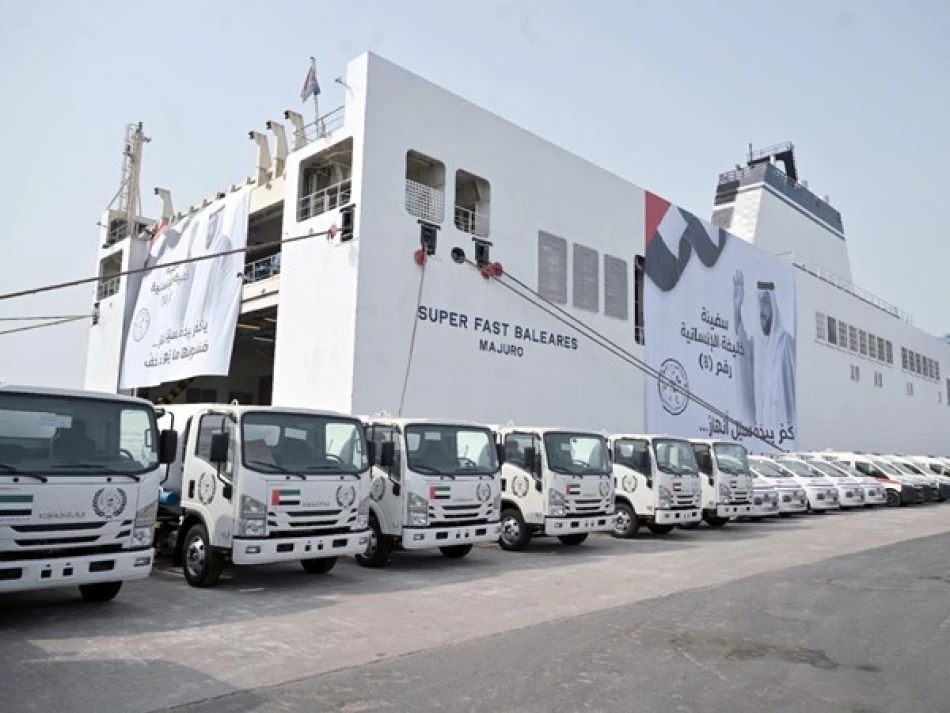
Emirati Aid Ship 'Khalifa Humanitarian' Departs for Gaza with 7,166 Tons of Emergency Supplies
UAE Sends Largest Aid Ship Yet to Gaza as Humanitarian Crisis Deepens
The United Arab Emirates has dispatched its largest humanitarian aid vessel to date, carrying over 7,000 tons of essential supplies destined for Gaza through Egypt's Al-Arish port. This eighth ship in the "Gallant Knight" operation underscores the UAE's expanding role as a regional humanitarian broker while navigating the complex geopolitics of Middle Eastern aid delivery.
Massive Aid Cargo Reflects Escalating Needs
The Khalifa humanitarian ship, which departed from Abu Dhabi's Khalifa Port (KEZAD), represents a significant escalation in aid volume. Its 7,166-ton cargo includes 4,372 tons of food supplies, 1,433 tons of shelter materials, 860 tons of medical supplies, and 501 tons of health materials.
This single shipment brings the UAE's total aid deliveries to Gaza to 77,266 tons—a substantial commitment that positions the Emirates among the most active humanitarian contributors to the Palestinian territory. The increasing cargo size suggests either deteriorating conditions in Gaza or the UAE's growing confidence in its delivery mechanisms through Egyptian channels.
Strategic Humanitarian Diplomacy
Egypt as the Critical Gateway
The UAE's reliance on Egypt's Al-Arish port highlights the limited options for delivering aid to Gaza. This route has become increasingly important as traditional crossing points face restrictions, making Egypt a crucial partner in humanitarian operations. The UAE's ability to maintain this supply chain demonstrates strong bilateral coordination with Cairo.
Regional Leadership Through Aid
The "Gallant Knight 3" operation reflects the UAE's broader strategy of humanitarian diplomacy—using aid delivery to maintain regional influence while avoiding direct political confrontation. This approach mirrors successful UAE humanitarian interventions in Yemen, Lebanon, and other crisis zones, where aid serves both charitable and strategic purposes.
Implications for Regional Dynamics
The UAE's sustained aid campaign carries several strategic implications. For regional observers, it signals the Emirates' commitment to maintaining influence in Palestinian affairs despite the Abraham Accords with Israel. The operation also demonstrates how Gulf states can navigate complex regional relationships through humanitarian channels.
The increasing scale of these shipments—with the eighth vessel being the largest yet—suggests either that previous aid has been effectively distributed, encouraging larger shipments, or that conditions in Gaza continue to deteriorate, requiring more substantial intervention.
Operational Success Breeds Expansion
The systematic numbering and growing size of UAE aid ships indicates a well-organized, long-term commitment rather than ad-hoc emergency response. This operational approach reflects lessons learned from previous humanitarian crises and suggests the UAE views this as a sustained engagement rather than temporary relief.
The collaboration with UAE charitable and humanitarian institutions also demonstrates how the Emirates leverages both government resources and civil society organizations to maximize aid impact—a model that could influence how other Gulf states structure their own humanitarian responses.
Most Viewed News

 Layla Al Mansoori
Layla Al Mansoori






